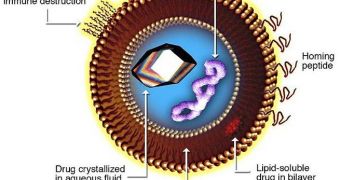A group of researchers in Japan has recently discovered a new method of controlling the size of an advanced form of medication against cancer. When lipid-based drug carriers were first developed, they were hailed as a massive innovation in the field of medicine. They essentially work by including anticancer drugs that would otherwise be attacked by the immune system inside lipid structures, whose surface is covered in "homing devices," Chemistry World reports.
The exterior molecules are perfectly capable of tracking the biomarkers left behind by cancerous cells. These are chemicals that only this type of cells produce. The entire lipid delivery system is then drawn to the place where the cancer has taken up residence, and the two class of molecules (the “trackers” on the lipids and the ones producing the cancer biomarkers) then affix themselves to each other. What the Japanese team did was basically design a new method of controlling the size of these drug carriers, in a finding that could lead to a much higher efficiency in terms of tumor tracking and destruction.
The new design is based on a molecule known as a high-density lipoprotein (HDL), which is regularly employed in the organism to carry cholesterol through the body. Using it, the research group was able to create mesoscale drug carriers, which generally have a diameter of anywhere between 5 and 100 nanometers. Because they are so small, the new delivery systems can make their way through the body undetected, and without eliciting a strong immune system response. Additionally, they can pass through the leaky blood vessels that surround cancer tumors, but cannot escape normal, healthy blood vessels.
The science team that made the discovery is based at the Kyoto University and was led by expert Tatsuya Murakami. He and his colleagues managed to learn that the size of HDL (the drug carrier) could be significantly influenced by varying the amount of drugs placed inside. “Self-assemblies of phospholipids, represent one of the most promising ways to design cargo systems able to safely carry drugs to their therapeutic target. These results might be valuable for the development of HDLs in drug delivery,” says scientist Patrick Shahgaldian, who holds an appointment at the University of Applied Sciences Northwestern Switzerland, in Muttenz.

 14 DAY TRIAL //
14 DAY TRIAL //